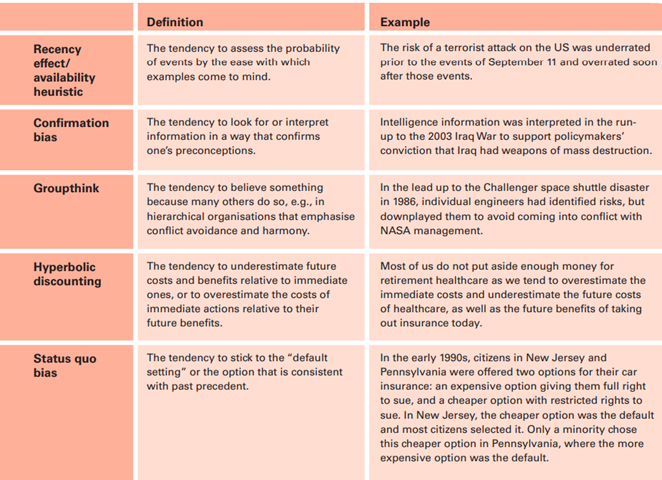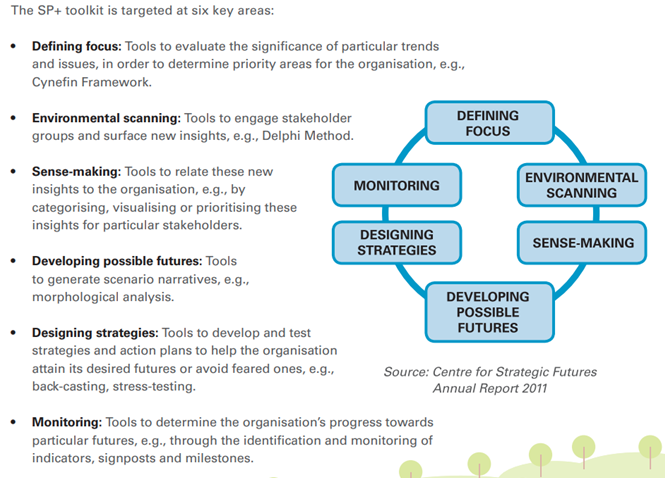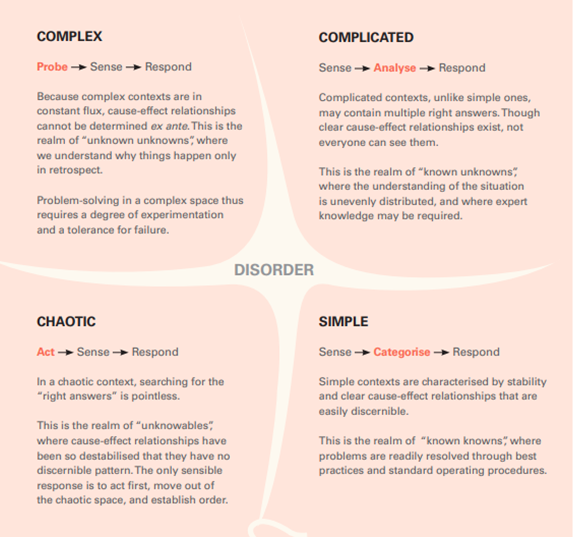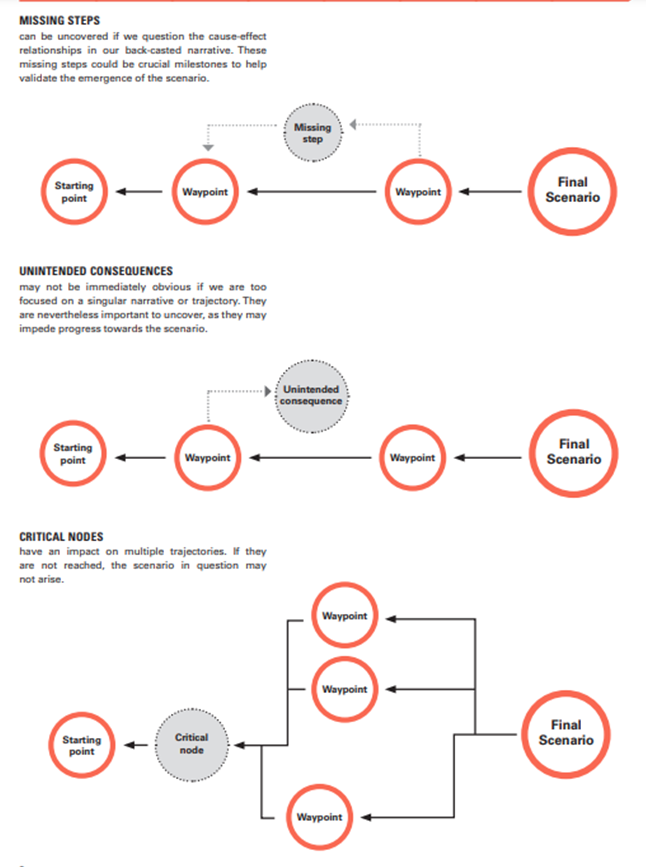Summary
- Singapore is an important case study for understanding and evaluating global best practices for improving institutional decision-making in governments, given its track record of public service excellence and innovation. Notably, Singapore is at the forefront of future foresight policy work, having started building capacities in this area since the mid-1990s.
- Scenario planning is an entry-level strategic tool for policymakers to solicit opinions on current policy-relevant trends and to identify possible future scenarios. However, Singapore’s public service found that this tool alone is prone to cognitive biases, limiting its usefulness to predict unprecedented trends or events in a complex world.
- Instead, a more holistic suite of foresight tools which explicitly address uncertainty, provide concepts for thinking about causality, and help pick up "weak signals", is useful to enhance long-termist policymaking.
- The effectiveness of foresight tools is fundamentally grounded in the broader excellence in whole-of-government policymaking culture, human capital development, and collaboration - essential preconditions to enable the higher-order thinking and culture for foresight.
Acknowledgements: A huge thank you to Victoria Clayton and Dilhan Perera of the Effective Institutions Project for seeding and providing key directions for this post.
Introduction
Governments are the defining actors that shape global society, yet fundamental research on how policy-making can be most effectively improved remains understudied. EA’s Improving Institutional Decision-Making (IIDM) cause priority, initially mooted by Jess Whittlestone in 2017, first formalized as the IIDM Working Group in December 2020, and in its present form as the Effective Institutions Project today, looks to change that.
The Project’s recent scoping survey sought to identify the defining topics which were “in scope of improving institutional decision-making”, looking at nine topics such as improving individual and group-level decision-making, using evidence and data, and improving whole-of-institution governance. The survey identified broad community agreement in the relevance of “improving knowledge about the future to affect plans now” as well as “improving whole-institution governance, leadership, and culture” for IIDM cause prioritization.
Being able to foresee and adequately plan for the future is an essential part of policymaking, but one which few governments today are adequately equipped for. Politicians are often said to prioritize short-term interests for political gain, while the pandemic in particular has shone the spotlight on the reactionary tendencies of many governments.
Only a handful of governments, all in advanced economies, have in-built futures foresight capacities, such as the UK’s Government Office for Science Futures team that seeks to support strategic long-term thinking in government. Yet, if Dominic Cummings’ word is anything to go by, the UK government still has a long way to go in terms of long-term policymaking.
The Case of Singapore
Singapore is a natural site of analysis for study of leading IIDM practices, with its reputation for quality public service delivery and policymaking. As an entrepot city-state dependent on the world economy, an effective government has always been a cornerstone to the country’s survival. And Singapore has the outcomes to show for it - it has been said, among other things, to have the best education system and public housing system, the most efficient healthcare system, to be the top smart city, and the best place to be during covid. In other words, Singapore is a prime candidate for an innovative government that long-termist EAs have argued should be worked with to test institutional innovations at scale.
Specifically, Singapore’s public service is at the cutting-edge for government futures foresight capability. Singapore has a dedicated Centre for Strategic Futures that serves to build capacities for developing insight into future trends for strategic anticipation and risk management. More broadly, the most recent model of governance adopted at a national level has been to see government as a “Complex Adaptive System” which faces high incidences of systemic risks and uncertainties, and having to consequently adapt and innovate.1
Three Key Questions
- What are Singapore’s tools for effective long-term planning?
- What are the reported benefits and limitations of these strategies?
- What are the institutional conditions that enable such long-termist policymaking?
This brief attempts to provide an informal overview of Singapore’s existing tools for futures foresight, as well as the broad conditions needed for successful implementation. I do this through an evidence synthesis of publicly-available documents published by Singapore’s Civil Service on their strategic planning tools. I also offer a basic analysis of key enabling factors based on my personal observations as a Singaporean, together with established public policy literature on the drivers behind Singapore’s broader public service excellence.
Full disclaimer that I am not a policy researcher, nor do I have experience in the public service. That said, I believe that this overview is still valuable for the global IIDM audience as a primer to initiate thought on the possibilities of enhancing long-termist policymaking and whole-of-institution governance.
Tool #1: Scenario Planning
As the first tool implemented in the mid-1990s across the entire public service to help policymakers make more informed assessments of the future, scenario planning is essentially about ideating “stories about the way the world might turn out tomorrow”, to aid with thinking about long-term strategic policy plans and questioning assumptions.2
Process & Benefits
A scenario planning exercise is usually conducted by a group of public officers from different backgrounds to ensure a diversity of perspectives, who research trends in the policy environment.1 The research typically revolves around interviews, where the team solicits opinions on trends, changes, and challenges from political office-holders, public sector leaders, as well as stakeholders from beyond the government.1 The process is iterative - the team generates key future scenarios and driving forces, presents them back to key decision makers, and obtain more feedback to refine the scenarios, ensure their relevance to the government’s needs, and generate a common understanding of the future.1
For example, one of the first national-level scenario planning exercises explored the possible futures of Singaporean national identity, including a scenario of a commercially successful Singapore but one where citizens were merely guests with no deeper national identity, and another where community identities were strong but specific to demographic groups.1 These scenarios highlighted how, at the time, social dimensions of national policies like identity and community were under-addressed, compared to economic and geopolitical dimensions. Scenario planning exercises were also conducted for more specific policy areas, including the role of social media in shifting societal dynamics and the long-ranging and multi-dimensional effects of climate change.1
Today, scenario planning remains an essential tool in the Singapore government’s strategic planning process. National-level scenario planning exercises are run every few years that deal with issues on a national scale, while ministry-level scenario studies focus on specific policy topics. To enable this, policymakers at the planning units of each ministry are trained in the key concepts and vocabulary of scenario planning, such as the ideas of driving forces, critical uncertainties, and branching points.1
Overall, the scenario planning process introduced an “anticipatory” mindset amongst Singapore’s public servants, to always have the “what if” questions in mind so as to be prepared for future challenges.3
Limitations & Cognitive Biases
Yet, after a series of unanticipated national crises at the turn of the 20th century, including the 1997 Asian Financial Crises and the 2003 SARS pandemic, Singapore found that scenario planning alone was insufficient to adequately identify future shocks, especially those which were unprecedented, and to respond to a rapidly changing and complex environment.1 Policymakers failed to respond to warning signals of imminent crises, despite access to ample information which could have enabled probabilistic prediction of future shocks and spurred corresponding precautionary measures.3
This was due to the tendency for policymakers to oversimplify future possibilities, such as through focusing on linear extrapolations of current trends, and discounting sharp, discontinuous shocks.1 It was a story about the nature of human cognition and cognitive failures, which include confirmation biases, hyperbolic discounting of future costs and benefits, groupthink, the availability heuristic, and missing incentives to prepare for surprises.3
A summary table of key concepts of cognitive failures by the Centre for Strategic Futures is presented below.4

In essence, the defining insufficiencies of the scenario planning process were twofold:
- Its failure to enable policymakers to anticipate future unprecedented events that diverged from historical norms, due to limited grasp of complexity theory, of understanding the non-linearity and emergence of unanticipated yet system-driven events.1
- The tendency to neglect taking precautionary measures for anticipated events with low estimated probabilities but game-changing impact, due to hyperbolic discounting.
A fundamental root of these issues was linked to the scenario planning’s weakness in collecting enough data to identify “weak signals of potential future shocks”. A more structured system was needed to “scan masses of data, both structured and unstructured, to look for weak signals, anomalies, and emergent issues”, as well as gather more evidence for low but increasing probability events to spur adequate policy precautionary measures.1
An op-ed published by Singapore’s Civil Service College summarises this issue of difficulty in not just detecting weak signals, but also communicating and taking seriously their implications, as well as possible solutions. (read here, p. 19).
Tool #2: Futures Foresight (or Scenario Planning +)
In response, Singapore’s Public Service sought to move away from a simplistic procedure of driving forces inputs and scenario outputs, towards an approach of building an ecosystem that encompassed a broader range of variables, from economic to social and technological dimensions, and to consider complex interactions between them.1
In the last decade or so, a broader framework of futures foresight tools was developed to complement scenario planning, called “Scenario Planning +”, to enable a more holistic scanning of emerging strategic issues.5 It involved the identification, filtering, and prioritization of issues known as “unknown unknowns”, which have not surfaced as critical but can be critical if they do.1 Added focus is deliberately placed on views from the private, social, and academic sectors, to tap on the “wisdom of crowds” and to avoid groupthink within government.
Process & Benefits

The process follows six broad reiterative steps, illustrated in the graphic above obtained from the Centre for Strategic Futures.4 I will not go into the details of these steps, but will simply cover a couple of the more interesting components below. The Centre publishes an overview of this approach here.
A key tool used under the “Defining focus” step is the Cynefin framework which divides problems into four quadrants depending on their nature of predictability. As summarized in the graphic sourced from the centre below,4 categorising issues through this framework helps government keep in mind the varying degrees of predictability across different issues, especially the presence of “chaotic” events which will be entirely indiscernible, and the need to be agile and adaptive to these trends as they surface.1

Another notable tool in Scenario Planning + under the “Designing strategies” step to cope with possible futures, is the tool of backcasting (Wikipedia definition here) - imagining specific desired or feared scenarios in the future and working backwards to identify possible causal paths and factors that could lead to these positive or negative outcomes. This is very similar to the idea of a pre-mortem (brainstorming reasons for a successful or failed future in general), as popularized in Daniel Kahneman’s Thinking, Fast & Slow, and now an established technique for policy analysis (shout out to Dilhan for pointing this out!).
The infographic below by the Centre illustrates various brainstorming concepts for backcasting to identify possible pathways towards an outcome, such as intermediate steps and critical junctions to work towards or avoid.4

The Scenario Planning + framework has been applied to analyze possible pathways to potential future crises in Singapore like food pandemics, global resource shocks, and cyber-terrorism.1
While specific scenarios and outcomes of these exercises are not publicly available, likely due to national security concerns, the Centre for Strategic Futures does publish an annual overview of their broad research agenda and “Emerging Strategic Issues” under their radar, which provide an idea of the kinds of possible futures under consideration. For example, the 2017 edition discusses future scenarios like the space industry, China’s rise as a tech superpower, and climate change, while the 2019 edition discusses the future of work, extending human lifespans, and changing identities in the digital era.
An independent summary of these publicly available scenarios, grouped into broad forces of the Future of Technology, Economy, Global Environment, and Singaporean Society, is published here (see Table 2: Driving Forces Cards 2035).
The piece also offers a critique of possible inadequacies in Singapore’s foresight process, including the neglect of social forces with overemphasis on economic and tech-driven ones, and the lack of transparency and public engagement which brings up the possibility of the process still being siloed within closed walls.
Outside of the centre, each ministry also has their own Futures unit which deal with ministry-specific policy futures. Ultimately, the framework helps to factor uncertainty into decision-making while also reducing it, through a systematic thinking process to gather as much information, frame the problem, and to identify key causal pathways. Such tactical models to improve institutional decision-making, particularly reducing uncertainty in complex decision-making, have also been previously highlighted by the EA IIDM community.
Broad Enabling Conditions
I discuss three general pre-conditions that come to mind that have enabled the effective implementation of such long-termist strategies in Singapore. Once again, I emphasize my lack of personal experience with policymaking and that these thoughts are layman observations from a Singaporean.
An essential contributing quirk about Singapore’s governing context which has to be acknowledged first is Singapore’s unique political stability. As a dominant-party system, where the ruling party has never lost power and is known for well-planned leadership transitions, Singapore’s political leaders and bureaucracy have had the privilege of a consistent party ideology and leadership, which is a significant factor for consistent long-term planning.
This suggests that Singapore’s long-termist approaches may be a bit harder to replicate elsewhere in the world, where governments change more often and politicians are more focused on short-term re-election goals. That said, political stability is not the only factor, whole-of-government management of public service talent, policymaking culture, and coordination are also fundamental.
Condition #1 - Public Sector Talent Management
The first thing that comes to mind about Singapore’s public service is its professionalism, which is grounded in the quality of its human capital. Right from our teenage years, the public service is largely seen as a respectable career in Singapore - it is generally acknowledged that the most prestigious goal of high school students is to attain a government scholarship for their university education, which also offers a fast-track career into leadership roles.
A cornerstone of talent management is paying competitive market rates aligned with each officer’s abilities and responsibilities, which the government sees as “absolutely essential to maintain the quality of public administration”. The salaries of all public officers are regularly reviewed to match private sector pay, and this has helped attract and retain talent to the public sector while also discouraging financial incentives for corruption.1 Furthermore, pay and promotion is performance-driven, thus aligning individual and organizational incentives.
Key mechanisms used to promote such meritocratic evaluations and reduce bias include stack ranking, where public service officers are ranked annually in relation to their peers by a panel of both direct and indirect supervisors, the much debated Currently Estimated Potential system, where all officers are rated on their long-term leadership potential, defined as the highest post an officer is estimated to be able to hold in their career, and an ostensibly neutral whole-of-government “Public Service Commission” body in charge of top-level leadership appointments and promotions.
The civil service also actively invests in upgrading its public officers. Funding opportunities are regularly offered for postgraduate training, such as MPP and MBA programmes, and also more technical specialist domain training.2 Altogether, these progressive human capital development policies in Singapore’s public service ensures a quality base of policy officers to begin with.
Condition #2 - Bureaucratic & Policymaking Culture
Coming to the actual policy-making, Singapore’s public service emphasizes the nurturing of good habits. In particular, a pragmatic, rational, unsentimental, and results-oriented approach is emphasized - promoting the hard assessment of policy outcomes in contrast to policymaking by ideology. Furthermore, civil servants are encouraged to “speak truth to power”, to be willing to develop independent opinions and defend views which may diverge from their superiors. The idea of a “networked government” is also emphasized - networking with individuals and organisations both within and beyond government, locally and internationally, to avoid groupthink, challenge thinking with contrarian and diverse views, and objectively test ideas.
An increasing focus is public transparency and a spirit of collaboration with the public. The crux is the emphasis that the public service does not have “a monopoly on ideas”, and “may not always have the answer”. To achieve this, Singapore is increasingly using crowdsourcing and co-creation opportunities to gather public opinion on policies and development. For instance, more than 17,700 suggestions were received from the public on developing the Jurong Lake Gardens, a sprawling national garden in suburban Singapore. Altogether, the policymaking culture of casting a wide net of ideas is a strategic bulwark to become aware of as many possible futures in a complex world.
Condition #3 - Whole-of-Government Strategic Coordination
Finally, whole-of-government collaboration is crucial to address complex issues. Notably, in 2015, Singapore created a new central strategic policy unit called the Strategy Group under the Prime Minister’s Office to better coordinate action on complex issues which are not under the purview of any single ministry.2 Accordingly, relevant functions of the group are the identification of emerging issues that cut across ministry boundaries, as well as to incubate new programmes to address policy issues for which no ministry is currently responsible for.2
Key Takeaways
Summary (once more)
- Scenario planning is an entry-level strategic tool for policymakers to solicit opinions on current policy-relevant trends and to identify possible future scenarios. However, Singapore’s public service found that this tool alone is prone to cognitive biases, limiting its usefulness to predict unprecedented trends or events in a complex world.
- Instead, a more holistic suite of foresight tools which explicitly address uncertainty, provide concepts for thinking about causality, and help pick up "weak signals", is useful to enhance long-termist policymaking.
- The effectiveness of foresight tools is fundamentally grounded in the broader excellence in whole-of-government policymaking culture, human capital development, and collaboration - essential preconditions to enable the higher-order thinking and culture for foresight.
Future Directions
- More case studies of how complex decision-making is conducted within institutions to share learnings.
- In-depth research to evaluate the effectiveness and best specifications of foresight tools, as well as relative benefits compared to other IIDM areas like evidence-based decision making, through empirical analysis of outcomes and incorporating actual experiences of policymakers.
Resources
For those interested in learning more about Singapore’s foresight capacities in detail, the following resources are the main references for this piece:
[1] Full historical overview of Singapore’s foresight strategy evolution: Conversations for the Future: Singapore’s Experiences with Strategic Planning. Centre for Strategic Futures, Prime Minister’s Office Singapore. https://www.csf.gov.sg/files/media-centre/publications/conversations-for-the-future.pdf
[2] Full historical overview of Singapore’s whole-of-government public service evolution: Building a Public Service Ready for the Future. Public Service Division Singapore. https://www.psd.gov.sg/heartofpublicservice/our-institutions/building-a-public-service-ready-for-the-future/
[3] Summary of common pitfalls & advice for futures work: Thinking about the Future: What the Public Service Can Do. Civil Service College Singapore. https://www.csc.gov.sg/articles/thinking-about-the-future-what-the-public-service-can-do
[4] Detailed repository of essential foresight concepts & vocabulary: Foresight: A Glossary. Centre for Strategic Futures, Prime Minister’s Office Singapore. https://www.csf.gov.sg/files/media-centre/publications/csf-csc_foresight--a-glossary.pdf
[5] Overview of the Centre for Strategic Futures’ foresight approach: Our Approach. Centre for Strategic Futures, Prime Minister’s Office Singapore. https://www.csf.gov.sg/our-work/our-approach/
Forum Discussion Prompts
- For policymakers with experience with foresight tools, how does Singapore’s experience line up with your experiences on the content, effectiveness and pre-conditions of such tools?
- For EAs with experience collaborating with governments on EA causes, how can EA most effectively contribute to increasing foresight capacities of governments?
- For social science/policy researchers, how can the effectiveness of such foresight tools be quantified and measured, including in relation to other policy making tools?

Apologies if you already linked to this and I missed it, but Dominic Cummings is also writing a series about Singapore right now: https://dominiccummings.substack.com/p/high-performance-startup-government